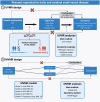Women's reproductive traits and cerebral small-vessel disease: A two-sample Mendelian randomization study
- PMID: 37064189
- PMCID: PMC10098092
- DOI: 10.3389/fneur.2023.1064081
Women's reproductive traits and cerebral small-vessel disease: A two-sample Mendelian randomization study
Abstract
Background: Observational studies have suggested that women's reproductive factors (age at menarche (AAM), age at first birth (AFB), age at first sexual intercourse (AFS), age at natural menopause (ANM), and pregnancy loss) may influence the risk of cerebral small-vessel disease (CSVD) although the causality remains unclear.
Methods: We conducted two-sample univariable Mendelian randomization (UVMR) and multivariable MR (MVMR) to simultaneously investigate the causal relationships between five women's reproductive traits and CSVD clinical [intracerebral hemorrhage (ICH) by location or small-vessel ischemic stroke (SVS)] and subclinical measures [white matter hyperintensities (WMH), fractional anisotropy (FA), and mean diffusivity (MD)], utilizing data from large-scale genome-wide association studies of European ancestry. For both UVMR and MVMR, the inverse-variance-weighted (IVW) estimates were reported as the main results. The MR-Egger, weighted median, generalized summary-data-based MR (GSMR), and MR-pleiotropy residual sum and outlier (MR-PRESSO) methods for UVMR and MVMR-Egger, and the MVMR-robust methods for MVMR were used as sensitivity analyses. Sex-combined instruments for AFS and AFB were used to assess the impact of sex instrumental heterogeneity. Positive control analysis was implemented to measure the efficacy of selected genetic instruments.
Results: We found no evidence to support causal associations between genetic liability for women's reproductive factors and the risk of CSVD in UVMR (all P-values > 0.05). Using MVMR, the results were consistent with the findings of UVMR after accounting for body mass index and educational attainment (all P-values > 0.05). Sensitivity analyses also provided consistent results. The putative positive causality was observed between AAM, ANM, and ovarian cancer, ensuring the efficacy of selected genetic instruments.
Conclusion: Our findings do not convincingly support a causal effect of women's reproductive factors on CSVD. Future studies are warranted to investigate specific estrogen-related physiological changes in women, which may inform current researchers on the causal mechanisms involved in cerebral small-vessel disease progression.
Keywords: MRI markers; Mendelian randomization; cerebral small vessel disease measures; intracerebral hemorrhage; small vessel ischemic stroke; women's reproductive traits.
Copyright © 2023 Wang, Lu, Weng and Zhang.
Conflict of interest statement
The authors declare that the research was conducted in the absence of any commercial or financial relationships that could be construed as a potential conflict of interest.
Figures





Similar articles
-
Exploring the causal relationship between female reproductive traits and frailty: a two-sample mendelian randomization study.Front Physiol. 2024 Mar 28;15:1349952. doi: 10.3389/fphys.2024.1349952. eCollection 2024. Front Physiol. 2024. PMID: 38606010 Free PMC article.
-
Women's reproductive traits and major depressive disorder: A two-sample Mendelian randomization study.J Affect Disord. 2023 Apr 1;326:139-146. doi: 10.1016/j.jad.2023.01.063. Epub 2023 Jan 20. J Affect Disord. 2023. PMID: 36682697
-
Identifying causal associations between women's reproductive traits and risk of schizophrenia: a multivariate validated two-sample Mendelian randomization analysis.BMC Psychiatry. 2024 Feb 24;24(1):161. doi: 10.1186/s12888-024-05614-5. BMC Psychiatry. 2024. PMID: 38395764 Free PMC article.
-
Phenome-wide Mendelian randomization study evaluating the association of circulating vitamin D with complex diseases.Front Nutr. 2023 Mar 29;10:1108477. doi: 10.3389/fnut.2023.1108477. eCollection 2023. Front Nutr. 2023. PMID: 37063319 Free PMC article. Review.
-
Review of mendelian randomization studies on age at natural menopause.Front Endocrinol (Lausanne). 2023 Sep 11;14:1234324. doi: 10.3389/fendo.2023.1234324. eCollection 2023. Front Endocrinol (Lausanne). 2023. PMID: 37766689 Free PMC article. Review.
Cited by
-
Association of age at first sexual intercourse and lifetime number of sexual partners with cardiovascular diseases: a bi-directional Mendelian randomization study.Front Cardiovasc Med. 2023 Dec 7;10:1267906. doi: 10.3389/fcvm.2023.1267906. eCollection 2023. Front Cardiovasc Med. 2023. PMID: 38146444 Free PMC article.
-
Exploring the causal relationship between female reproductive traits and frailty: a two-sample mendelian randomization study.Front Physiol. 2024 Mar 28;15:1349952. doi: 10.3389/fphys.2024.1349952. eCollection 2024. Front Physiol. 2024. PMID: 38606010 Free PMC article.
References
LinkOut - more resources
Full Text Sources

